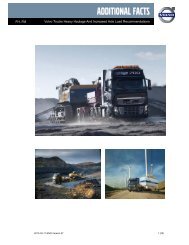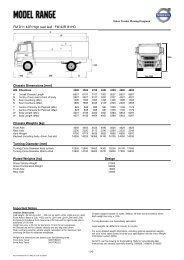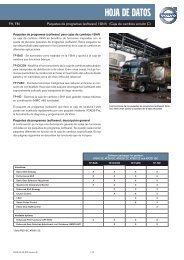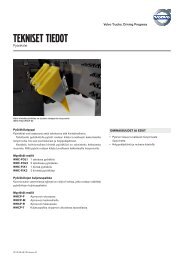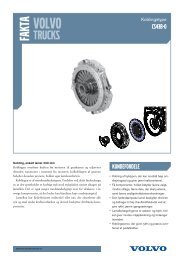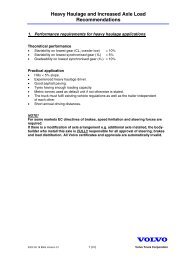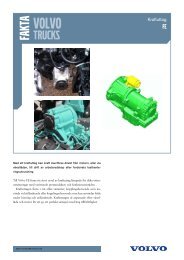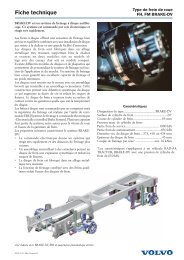Create successful ePaper yourself
Turn your PDF publications into a flip-book with our unique Google optimized e-Paper software.
<strong>Fact</strong> <strong>Sheet</strong><br />
The CS43B-O is a drag-type clutch with a single friction<br />
disc that is 430 mm in diameter.<br />
A drag-type clutch is disengaged when the release bearing<br />
pulls the centre of the diaphragm spring outward. This<br />
design makes the clutch easy to use and makes the<br />
engagement action light and progressive when driving in<br />
close quarters. Single discs are particularly suitable for<br />
driving with few starts.<br />
The purpose of the clutch is to transfer power from the<br />
engine to the gearbox, but it also absorbs variations in<br />
torque from the engine.<br />
An inspection hole for range-/splitter gearboxes simplifies<br />
monitoring disc wear. There is a damper located at the<br />
centre of the clutch disc that consists of a number of<br />
torsional springs attached in such a way that the centre of<br />
the disk can twist slightly in relation to the linings. The<br />
springs absorb any jolts, which protects components in the<br />
driveline and increases their service life.<br />
Clutch<br />
CS43B-O<br />
The CS43B-O has friction linings made of a heatresistant,<br />
asbestos-free material. The pressure plates and<br />
flywheel have great heat absorbing capacity and the disc<br />
linings can withstand high temperatures. This contributes<br />
to excellent durability and low maintenance costs.<br />
The following features characterize the CS43B-O:<br />
• The clutch fork for range-/splitter gearboxes has a<br />
spherical bearing in the clutch casing, which enables<br />
the fork to cope with uneven loads and to ensure good<br />
disengagement.<br />
• A drag-type clutch requires low disengagement forces<br />
and provides good manoeuvrability. A single disc is<br />
best suited for driving with few starts.<br />
• A large friction area offers good durability, which means<br />
good profitability.<br />
• An inspection hole for range-/splitter gearboxes<br />
simplifies monitoring disc wear.<br />
• The friction disc has asbestos-free linings, and<br />
cushioning pads that distribute pressure evenly over<br />
the entire surface.<br />
• The clutch consists of few parts, which results in low<br />
weight, and low wear and maintenance.<br />
Specifications<br />
Designation ................................................... CS43B-O<br />
Type......................................... Single, drag-type clutch<br />
Type of disc .................................................... Dry disc<br />
No. of discs ................................................................ 1<br />
Disc diameter ..................................................430 mm<br />
Disc damper’s diameter (A) ............................. 212 mm<br />
Disc damper’s diameter (B)..............................232 mm<br />
Disc damper’s diameter (C) ............................. 254 mm<br />
Total friction surface of the disc (A,B) ........... 2000 cm 2<br />
Total friction surface of the disc (C) .............. 1842 cm 2<br />
Weight including disc (A) ................................. 46.8 kg<br />
Weight including disc (B) .................................. 47.9 kg<br />
Weight including disc (C) ................................. 46.9 kg<br />
Ref: ............................. (A) = Engine torque
<strong>Fact</strong> <strong>Sheet</strong><br />
Easy-to-use, single disc<br />
clutch<br />
CS43B-O consists of a friction disc<br />
(1), pressure plate (2), and a release<br />
bearing (3). The disc has a hub with<br />
inner splines. The hub is located on<br />
the gearboxes’ input shaft, which has<br />
corresponding outer splines. This enables<br />
the disc to slide along the shaft.<br />
This design offers good manoeuvrability.<br />
3<br />
2<br />
Drag-type clutch for<br />
smooth operation<br />
In the engaged position, the diaphragm<br />
spring, a “fan spring” (1) , presses the<br />
pressure plate (2) , which in turn<br />
engages the clutch. When the clutch<br />
is engaged, power from the engine is<br />
transferred from the flywheel (3) via<br />
the friction disc (4) through the hub<br />
(5) to the gearboxes’ input shaft (6).<br />
When the clutch pedal is depressed,<br />
force is transferred to a fork (7) that<br />
pulls the release bearing (8) rearward<br />
towards the gearbox.<br />
The release bearing pulls the centre of<br />
the diaphragm spring, removing the<br />
pressure on the disc. The disc stops<br />
rotating, while the flywheel and the<br />
pressure plate rotate at the same speed<br />
as the engine.<br />
This means that the gearbox receives<br />
no power from the engine, and the<br />
gearbox input shaft stops rotating if<br />
the gearbox is in the neutral position.<br />
Clutch<br />
CS43B-O<br />
Disc linings with long<br />
service life<br />
The disc consists of a steel plate with<br />
friction linings riveted to both sides.<br />
The linings are made of heat-resistant<br />
and asbestos-free material that can<br />
withstand the high temperatures that<br />
are generated when the disc slips during<br />
starts.<br />
Cushioning pads are located between<br />
the linings and the steel plate, which<br />
distribute pressure evenly over the<br />
entire friction surface, resulting in a<br />
long service life.<br />
A damper, in the form of torsional<br />
springs, is located around the centre of<br />
the disc. Its purpose is to absorb any<br />
jolts or vibrations. There is also a<br />
smaller damper that eliminates idling<br />
noise from the gearbox.<br />
1<br />
Smooth clutch action for<br />
high driver efficiency<br />
The clutch is operated with the help of<br />
a compressed-air servo, to make gear<br />
shifting easy for the driver.<br />
The servo is run by a hydraulic system<br />
where the master cylinder is located<br />
near the clutch pedal in the cab. The<br />
cylinder and fluid reservoir are accessible<br />
through the service hatch at the<br />
front of the truck. The function of the<br />
servo in the system is to convert the<br />
hydraulic pressure from the master<br />
cylinder, with the help of compressed<br />
air, into mechanical movement.<br />
The compressed air-assisted hydraulics<br />
means that low pressure on the<br />
clutch pedal results in smooth engagement/disengagement<br />
of the clutch. This<br />
contributes to high driver efficiency.<br />
3<br />
4<br />
5<br />
6<br />
Lamellen Disc engaged inkopplad<br />
2<br />
1<br />
8<br />
7<br />
Lamellen Disc disengaged frikopplad



